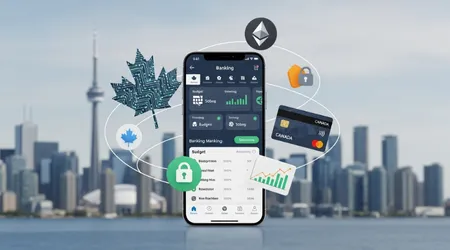Digital Banking & Fintech Tools in Canada: How to Manage Money Smarter

Digital Banking & Fintech Tools in Canada represent an irrevocable shift in how Canadians interact with their money, moving from physical branches to seamless digital platforms.
This transformation, accelerated by technological innovation and evolving regulations, demands a new approach to personal financial management.
The days of accepting high fees and low interest rates as the inevitable cost of convenience are rapidly fading.
Forward-thinking Canadians are now leveraging sophisticated applications to save more, spend smarter, and invest with unprecedented ease.
The financial services landscape in Canada is experiencing a fundamental re-engineering, challenging the dominance of the traditional “Big Five” banks.
New digital-only banks and specialized fintech firms are forcing incumbents to innovate or risk losing an entire generation of digitally savvy clients.
Understanding these tools is no longer optional; it is a prerequisite for optimizing your financial health in 2025 and beyond. This is your essential guide to harnessing this technological wave and seizing control of your financial destiny.
Why Are Canadians Shifting to Digital-First Finance?
The compelling shift toward digital banking is driven primarily by cost efficiency and superior user experience, fundamentally changing consumer expectations. Branch visits have become relics of a less efficient era.
What Are the Financial Advantages of Digital Banking in Canada?
The most immediate benefit of choosing a digital bank is the significant reduction, or complete elimination, of monthly service fees.
Traditional banks maintain massive physical infrastructure, a cost invariably passed on to customers through service charges.
Digital-only institutions, lacking the overhead of brick-and-mortar locations, are free to pass those savings directly back to you.
They often offer high-interest savings accounts (HISAs) with rates that dwarf the near-zero returns of conventional chequing accounts.
This dynamic creates a competitive pressure that benefits every consumer. Consider the monthly savings: foregoing an average $\$15$ monthly fee equals $\$180$ per year returned to your pocket.
Furthermore, many Digital Banking & Fintech Tools in Canada provide unlimited, free Interac e-Transfers, a service that often incurs fees at older institutions unless minimum balances are maintained. These small differences accumulate into substantial savings over time.
Financial institutions, whether digital or traditional, must adapt to modern consumer demands for accessibility and transparency.
The superior interface design and intuitive mobile apps from fintechs make managing money less of a chore and more of an integrated daily activity.
++ Saving for Retirement: What CPP & OAS Can and Can’t Cover, Plus Private Options
What Role Does Innovation Play in Customer Experience?
Innovation in the digital sphere moves at a lightning pace, providing tools the traditional sector often struggles to integrate.
Digital Banking & Fintech Tools in Canada are leveraging Artificial Intelligence (AI) to enhance both service and security.
For example, Canadian organizations show a strong adoption of AI in finance, with an 82% adoption rate, which is higher than the global average of 71%, according to a 2025 KPMG report.
This technological edge results in hyper-personalized customer support and fraud detection systems that flag suspicious activity in real-time.
The user experience often defines the success of a fintech application. Features like automated goal-setting, expense categorization, and instant budgeting alerts transform how individuals engage with their money, fostering better habits.
Digital platforms provide a level of data granularity that empowers users. They move beyond simple transaction lists to offer actionable insights, enabling true financial optimization without the need for a financial advisor for basic tasks.

How Will Open Banking Transform the Financial Landscape?
The forthcoming implementation of Canada’s Consumer-Driven Banking (Open Banking) framework represents a pivotal moment, poised to inject unprecedented competition and consumer control into the market.
What are the Benefits of Secure Data Sharing for Consumers?
Open Banking will legally require financial institutions to securely share a customer’s financial data with accredited third-party fintech apps, but only with explicit consent. This secure data portability is a game-changer.
Imagine using a single app to view all your accounts chequing, savings, investments, and credit cards across different institutions simultaneously. This provides a holistic, real-time view of your entire financial universe.
This unified visibility simplifies complex financial decisions, allowing third-party tools to offer superior, personalized advice on everything from debt consolidation to investment opportunities.
Open Banking facilitates an enhanced ability to compare products, forcing financial services to compete fiercely on features and price.
For consumers, the most powerful aspect is the control: you decide who sees your data and for how long.
The Consumer-Driven Banking framework emphasizes transparency and accountability, placing the individual at the centre of their financial data ecosystem.
Also read: Inflation & Cost of Living in Canada: Smart Strategies to Protect Your Budget
Why Will Open Banking Fuel the Growth of Fintech Tools in Canada?
The arrival of Open Banking drastically lowers the barrier to entry for innovative fintech startups. Previously, obtaining transactional data required tedious and often risky “screen scraping,” but APIs will now facilitate secure, permissioned access.
This streamlined access means new fintech applications can be developed rapidly, offering specialized niche services that traditional banks overlook.
Think of apps tailored for newcomer credit building, personalized small-business lending, or hyper-efficient tax optimization.
This innovation surge will benefit consumers by driving down the cost of specialized financial advice and democratizing access to sophisticated wealth management tools.
Digital Banking & Fintech Tools in Canada will compete not just on price, but on ingenuity and user-centric design.
This shift promotes a meritocracy in the financial sector where the best product wins, irrespective of the size of the institution offering it.
Will traditional banking giants be able to match the agility of a startup built purely on consumer-driven data?
Read more: How the Bank of Canada’s Interest Rate Cuts Affect Your Mortgage & Loan Payments
What Practical Examples Show the Power of Fintech Integration?
The real power lies in integrated functionality, exemplified by two original scenarios:
A fintech tool analyzes your daily spending and detects a recurring pattern of small, non-essential purchases (e.g., daily coffee).
It uses a “round-up” feature to automatically transfer the change from every transaction into a high-interest savings account.
If you spend C$4.50, C$0.50 is instantly saved. This effortless, invisible saving is a core advantage of Digital Banking & Fintech Tools in Canada.
Under Open Banking, you authorize a mortgage broker’s app to access your verified financial data from three different banks.
The app instantly generates pre-approval offers from 15 different lenders, using verified, real-time data, reducing the application time from weeks to hours and securing the best available rate without manual document gathering.
How Can Consumers Use Fintech for Smarter Money Management?
Fintech platforms offer a diverse toolkit for budgeting, investing, and automating financial discipline, transforming abstract financial goals into achievable realities.
H3: Which Budgeting Tools Offer the Most Value?
Modern budgeting apps, a key component of Digital Banking & Fintech Tools in Canada, move beyond simple spreadsheets to offer predictive and behavioral insights.
They don’t just record spending; they forecast future cash flow based on established patterns.
They use features like “envelope budgeting” (digitally allocating funds to specific categories) and “reverse budgeting” (paying yourself first) to enforce discipline.
By linking directly to all your accounts, they eliminate manual data entry, providing an always-accurate financial picture.
These intelligent systems analyze your spending habits to identify hidden, recurring subscriptions and suggest proactive cancellations, directly improving your discretionary cash flow. This proactive intervention is something generic bank statements cannot offer.
What is the Canadian Trend in Robo-Advisors and Investing?
Robo-advisors have democratized investing in Canada, offering low-cost, professionally managed portfolios through user-friendly digital platforms. They replace expensive human advisors for many entry-level and intermediate investors.
These tools build and automatically rebalance diversified portfolios using low-cost Exchange-Traded Funds (ETFs), ensuring your investments remain aligned with your risk tolerance and goals.
Their low management fees, often less than 0.5%, significantly outperform the mutual fund fees of 2.0% or more common in traditional banking.
The shift toward these transparent, efficient investment solutions is a major part of the broader adoption of Digital Banking & Fintech Tools in Canada.
This accessibility means more Canadians, especially younger generations, are starting to invest earlier.
Using traditional banking for budgeting is like navigating Canada with a paper map from 1990; it gets you there eventually, but with many wrong turns and delays.
Using modern fintech is like having a real-time GPS that also analyzes traffic patterns and suggests the fastest, most cost-effective route before you even leave home.
How Do Fees Compare Between Traditional and Digital Banks?
The difference in cost structures is stark, revealing a clear financial incentive for modern consumers to explore digital options. This table illustrates the tangible savings available now:
| Account Type Comparison (Representative Example – October 2025) | Traditional Bank (Premium Chequing) | Digital-Only Bank (No-Fee Account) | Annual Saving/Benefit |
| Average Monthly Fee | C$16.95 | C$0.00 | C$203.40 in Fees Avoided |
| HISA Interest Rate (Standard) | 0.05% – 0.25% | 2.50% – 4.00% | Significantly Higher Returns |
| e-Transfer Fees | C$1.00 – C$1.50 per transaction | Unlimited Free | Maximize Transaction Efficiency |
This data confirms that the lack of physical branches directly translates into higher returns and lower costs for the end-user.
Why pay for convenience you don’t use when you can bank from your pocket for free and earn more interest?
Conclusion: Seizing the Financial Advantage
The revolution driven by Digital Banking & Fintech Tools in Canada is a permanent one. It promises a future where financial services are transparent, consumer-centric, and aggressively competitive.
The core lesson is empowerment: you have the tools to demand more from your money, and the technology to enforce better financial habits without effort.
By actively exploring no-fee digital banks, embracing the coming efficiencies of Open Banking, and utilizing smart budgeting applications, you move from passively managing money to proactively growing your wealth.
Don’t be the last to switch; the time to adopt this smarter way of managing money is now, not tomorrow.
Share your experience in the comments: Which single fintech tool has made the biggest, tangible difference in your financial life this year?
Frequently Asked Questions (FAQ)
Are Digital Banks in Canada Safe and Federally Insured?
Yes. Most major digital-only banks operating in Canada are federally regulated and are members of the Canada Deposit Insurance Corporation (CDIC).
This means your eligible deposits are insured up to C$100,000, just like traditional banks. Always confirm a bank’s CDIC status before opening an account.
What is the Main Difference Between a Digital Bank and a Fintech App?
A digital bank (like a traditional bank) holds your money and is federally regulated as a financial institution.
A fintech app is a technology company that offers specific services (like budgeting, investing, or payment processing) and often needs to partner with a bank or access your data via Open Banking to function.
Does using multiple fintech apps make my finances too complicated?
It can if not managed properly. The goal of Open Banking is actually to simplify multi-app usage by allowing a central financial management app to consolidate all your accounts from various institutions and services into a single dashboard, providing a clear, unified view.
How do I get a human representative if a digital bank doesn’t have branches?
Digital banks typically invest heavily in 24/7 customer support via phone, live chat, or secure in-app messaging.
Since their staff is not dedicated to branch traffic, response times for critical issues are often faster than waiting in line at a traditional bank.
